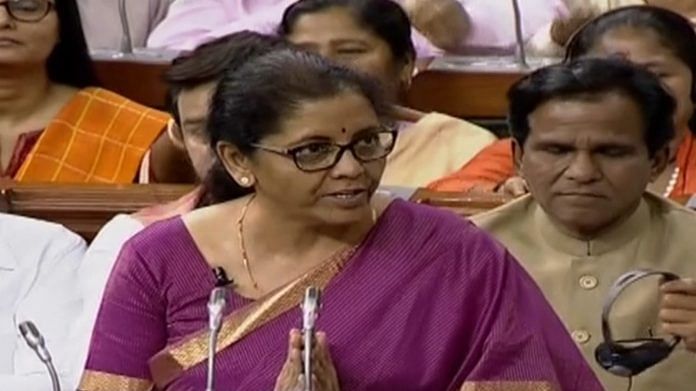New Delhi: The Modi government Friday lowered the fiscal deficit target for 2019-20 to 3.3 per cent of gross domestic product in 2019-20, contrary to expectations of a fiscal stimulus to boost growth.
The interim budget for 2019-20, also presented by the Modi government in February, had forecast a fiscal deficit of 3.4 per cent of GDP in 2019-20 while revising the fiscal deficit upwards for 2018-19 to 3.4 per cent from 3.3 per cent.
Speculation suggested that Finance Minister Nirmala Sitharaman will deviate from the path of fiscal consolidation as the economy faces the massive challenge of sharp slowdown in growth led by a deceleration in both investment and private consumption, especially in rural areas.
Data released by the Central Statistics office on 31 May showed that the Indian economy slowed to a 5-year low of 5.8 per cent in the quarter ended March and the full year growth slowed down for the second consecutive year under the Modi government to 6.8 per cent.
The growth was at 7.2 per cent in 2017-18 and at 8.2 per cent in 2016-17.
In her maiden budget speech, Sitharaman announced a series of steps to raise tax revenues, including a surcharge on the super rich and an increase in the excise duty and cess on petrol and diesel. She also said that the government plans to start raising a part of its gross borrowing programme in external markets in external currencies.
“This will also have beneficial impact on demand situation for the government securities in domestic market,” she said.
The finance minister added that India’s sovereign external debt to GDP is among the lowest globally at less than 5 per cent.
The government has also laid out an aggressive disinvestment programme to augment non-tax revenue collections.
Slowdown impact on Indian economy
The slowdown in growth has adversely impacted tax collections making it even more difficult for the government to find the funds for its social sector schemes and capital expenditure. While direct tax collections were 6 per cent lower than the revised estimates, indirect tax collections were down 10 per cent than even the revised lower tax projections.
However, there were fears that an increase in the fiscal deficit and subsequently government borrowings is likely to push up interest rates thus raising fears of ‘crowding out’ private investment at a time when the sector is reluctant to invest.
Economists and brokerages, however, had said the bond markets have already factored in a 10-20 basis points increase in the fiscal deficit number to compliment the rate cuts by the Reserve Bank of India (RBI) and deem it necessary to support waning growth.
The RBI had cut key policy rate thrice by 25 basis points each beginning February this year. However, these rates are yet to be fully passed on to the final consumer by the banks.
Also read: This is how Modi govt managed to keep 2018-19 fiscal deficit ‘artificially low’
The monetary policy committee statement, after the 25 basis points rate cut in June, had talked about how the growth impulses have weakened significantly and justified the rate cut to boost aggregate demand and investment activity.




This seems to be a housewife’s approach to the national finances – that is making both ends meet as far as possible. That’s why the fiscal deficit has been brought down. Even though the foreign borrowing, instead of domestic borrowing, might help to certain extent, the resources available for investment and growth has been restricted. The individual savings will not pick up because the interest rates on small savings is being reduced from time to time. On the whole the budget is recessionary. May not help the required annual GDP growth of 8% for achieving the $ 5 trillion economy in next five years.
Praiseworthy. A fiscal splurge is understandable in the last Budget, not the first one. The government needs to leave more resources for the private sector.